#nasarids
Photo

14th century sword of a Nasarid Emir || 9gagrss || https://ift.tt/oqIShWX https://ift.tt/3G9gvIK ||
0 notes
Text
Alhambra - A Maze of Mystery
Granada’s last proclamation of love to the Moors

The Alhambra palace complex, Granada
On the secluded Sabika hill, by the lavish banks of river Darro, rigorously protected by the brooding Sierra Nevada peaks and surrounded by a dense forest, lies Granada’s last proclamation of love to the Moors. The Alhambra rises majestically over the vast green plains, resembling a magical vision, for it was built to impress!
This splendid monument with its sturdy and robust outer walls hides a delicate and fragile interior. The emblematic fortified palace started its life as a walled citadel before becoming the opulent seat of Granada’s Nasrid Emirs. Its construction was ordered in the 13th century by the Nasrid Emir Mohammed Ibn Yusuf Ben Nasr, also known as “Al Ahmar”. It is one of the best-preserved palace complexes in the Islamic world and represents Moorish rule in Spain.
Moreover, it was the last Moorish, Muslim state and stronghold in Al Andalus. Alhambra is a construction wonder, so sophisticated that we first now, after 500 years, start to realise, and learn its true potential.
From underground tunnels that snake below the palace’s surface to enigmatic carvings are just now being understood, is Alhambra finally revealing its mysteries?
Alhambra is not just a palace, even though it is often referred to as such, but this place is actually a whole citadel within the city of Granada. It has a complex of different palaces, gardens, passageways, and a fortress. It became the home to the Sultan and his family, as well as the home to the court, and many workers.
The Alhambra is the only extended citadel that still stands today almost as perfectly as it was since the beginning. The colourful name Alhambra originates from the Arabic word; al-Hamrā, which means “the red one”.
There are several reasons for the name, one alludes to the colour of the fortress, which in Arabic is; al-Qal’at al-Hamrā or, “the red fortress”. In addition, the rulers of Alhambra derived from a Berber tribe called al-Ahmar meaning “the red”.
The red palace city is built from Tapia earth, found at the foot of the Sabika hill. The palace complexes got their colour from this red earth, but the surroundings are just as colourful, there is no confusion as to where it got its name.
The old historical path embedded in mystery and a witness to a murder

Wall towers of the Alhambra palace complex, Granada
Having sorted out the origins of the name Alhambra, we can further conclude that this reddish palatial city is beyond the shadow of a doubt a palace of concealed wisdom and ancient secrets, yet to be discovered.
Even though the old historical path of upper Alhambra, leading to the elevated levels of the citadel is commonly known, it is also embedded in mystery and even witnessed an ancient murder.
In the front of the gate ruins, in the oldest part of Alhambra for which any remains have been found, that served as an entryway to the remains of the stone-paved road that once joined the inside of the palace Medina to the outside gates, known as Arrabal. Even though the portal now feels more like a gateway to travel in time, as if it would bring you into the Nasrid’s glorious past.
Here is where the path, scattered with divers towers and named “the promenade of the towers” began. The reason for its name is the fact that this route, which followed the main wall of Alhambra, from the portal gardens to the upper Alhambra passed by a number of towers*. The towers stood out as milestones along the narrow path. The trail started by the tower of the pointed battlements.
*Six of the 30 Towers are named as follows; the tower of pointed battlements, the tower of the Cadí, the captive’s tower, the infant tower, the career corporal’s tower, and the water tower.
The walk intermittently crossed landscaped terraces filled with the Damascus rose, jasmine and trumpet creepers over a fortress wall. From up here, you could also see the pink blossoms and, sometimes if they are blooming, even smell the sweet scent of the crape myrtle trees. It is one of the loveliest views from upper Alhambra.
It was on this same path, somewhere from these altitudes, on the 19th of October 1354, through the dense morning mist that a security guard spotted the young Sultan Yusuf I initiating his daily morning prayer. It was just before daybreak, and even though it was still dark and foggy, he could see from up here how Sultan Yusuf’s bodyguard suddenly launched on the praying Emir with a knife and stabbed him to death, Yusuf was only 33 years old.
It was no coincidence this guard was up here witnessing the murder unfold. In historical times this path was frequented by both guards, military personnel and messengers. The towers served multiple purposes, as accommodation containing bedrooms, as a lookout to guard the inner palace complexes and the outside areas of the citadel from danger, as well as controlling who entered and exited the city.
It also served complex military purposes, but it was also a location for sending and receiving secret mirror messages from far away places. These messages were sent throughout the entirety of al-Andalus forming a complex and sophisticated network of mirror signalling, to exchange information and as an early warning, in case of danger. This practice and way of communication was especially important and vital to the Muslim states in al Andalus during the later periods of its existence.
To receive information as early as possible was key to survival, and the Nasrids rulers of Alhambra were exceptionally progressed and elaborated in these techniques. Alhambra was probably the most advanced of all Moorish states, and as a result of their advancement in the field, they were the last standing Moorish settlement in the Iberian peninsula at the end of the existence of al-Andalus.
The Muslim architects who built the citadel were geniuses, there is no doubt about that. There are plenty of fascinating building surprises hidden in Alhambra. For instance, they used anti-seismic structures in their buildings, well aware that the region was a seismic area. Alhambra was no exception, thanks to its seismic building knowledge it has survived earthquakes for almost 800 years.
They used lead foils in between the columns and the foundations, so whenever there was an earthquake the building followed the movement without collapsing.
The talking walls
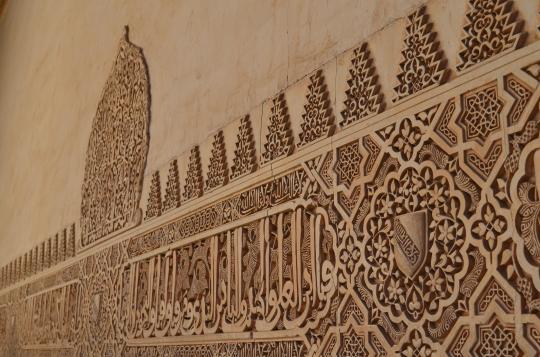
Walls of the Alhambra palace carved with calligraphic text.
The walls can talk, not literally, the walls are not exactly going to speak to you, but the walls of Alhambra do have words carved all over them. The enigmatic inscriptions on the walls are a type of calligraphic decoration as well as they rely on a message, in the form of poems that describe parts of the holy Quran. The palace also used water lilies to create scent in its rooms.
Isn’t it amazing how the sabika hill, Sierra Nevada mountain chain and the rest of al Andalus have lived more time listening to Arabic than they have to Spanish?
For almost 800 years, this place witnessed power and love stories from the Muslim Sultans; but has only witnessed Spanish passion for a little over 500 years. But don’t worry if you don’t speak Arabic, there is always someone to ask who can explain the beauty of these phrases to you.
One of the most interesting facts about the Alhambra is that besides being a giant book, it can also tell you what time it is. The truth is that the genius architects surprise us again with yet another amazing feature, the entire palace complex is perfectly aligned to work as a massive sundial. Just by watching the sun and the shadows in the red palace, you will know what time it is.
At noon, half of the rooms will have shade, and the other half sunlight, so choose your visit time wisely!
The chambers of secrets
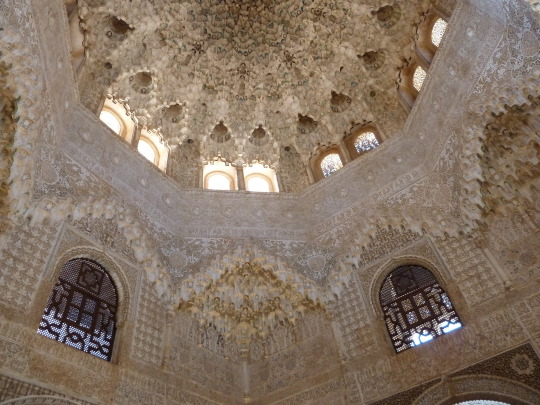
Whispering galleries can also come to be beneath a dome or vault, like in this lovely decorated ceiling in Alhambra.
The Alhambra does actually have its own “chambers of secrets”, also known as the whispering gallery. The reason for its name is, yet another architectural feature, created in the palace.
The Andalusian builders constructed a curation in the ceiling that made the sound travel from one corner of the room to the other, so be careful what you say and to whom you say it too, and don’t share any secrets while you are there!
Something that any engineer or architect lover realises as soon as they step foot in Alhambra is mathematical precision as the main element of construction. The beauty that you will see in this place is all thanks to minuscule mathematical calculations, and perfect engineering and geometry in the structures, decorations and tiles.
However, the original Muslim architects are said to have left unnoticeable imperfections in the decorations and tiles, as they used to say;
“only God can do perfect”.
If you want, you can take on the challenge and try to find some!
A network of tunnels

Tunnel in the Alhambra, Granada
Standing on the beautiful square of “Paseo de los tristes” in Granada, with your back facing the old Arabic neighbourhood of Albaicin, you look up at the forbidden walls of Alhambra, the most iconic Moorish monument in Spain. Beneath you, and separating you from this great 10th-century fortress is the Darro river, which gurgles through central Granada amidst lush banks and under century-old bridges.
If you look closer, set into the steep hillside, beneath a gracefully crumbling old townhouse, are small iron gates almost entirely obscured with grass and ivy. These are the entrances to just a few of what is believed to be an extensive network of underground tunnels linking the Alhambra to Albaicin and the rest of the city.
This secret world beneath one of Spain’s most famous attractions has recently made the Spanish news. Even if the track on the dilapidated bank of the Darro river that faces the paseo de los tristes is open to visits, it is only one month a year and only small groups of visitors are allowed.
On one hand, this is because of security risks as these deteriorated, badly kept tunnels can pose a danger to the visitors but also the other way around; mass tourism can damage the already old and fragile tunnel system. They seem set to remain shrouded in mystery and legend, and to keep their dark secrets forever.
However, the extended tunnel network that snakes below the glorious palace-city, would in its time, have served several purposes. The enigmatic subterranean pathways consist of at least 21 underground dungeons, meticulously connected to the ancient underground passages. These dungeons were linked to the outside world only by small openings in their ceilings, and they had access to the earlier mentioned labyrinth web. The caverns are believed to have served as storages for, amongst other things, grain, wheat, and other necessities.
As for the entire labyrinth of tunnels; it would have allowed the residents of the palatial city to come and go unseen, especially important during sieges and as a last resort for the Moorish rulers, in need of urgent escape.
The secret underground network of tunnels would prove to be of utmost importance when the Moorish rule came to its end, and the Nasrids lost their grip on power and abruptly faced their downfall. As the 800 years of glorious Moorish rule was over, everyone remaining with a dissimilar opinion to the new re-conquers faced harsh retribution, and was either killed, exiled, or underwent the most horrible torture imaginable. The country entered a very dark and eerie time period, a time that struck terror into the rest of the known world and shook it to its core.

Court of the Lions by night, Alhambra, Granada
The beauty and splendour of the Nasrids palace city is incomparable to anything ever seen. The mathematically calculated architecture combined with the sophisticated fragile artwork, ornated with fine details, rough robust walls and delicately decorated pillars everything is in perfect balance, in a divine harmonic symphony!
Alhambra radiates sophistication, elegance and mystery, a greatness that words fail to describe. A superior jewel beyond comparison.
But with great beauty comes great pain.
#history#writers on tumblr#writblr#writers#original content#travel#spain#alhambra#Al-Hambra#granada#moors#moorish#nasarids#nazarids#nasrids#court of the lions#palace#palace complex#tower#towers#wall#arabs
30 notes
·
View notes
Photo

Jinete Sword of Boabdil (Muhammad XII) Last Nasarid Emir of Granada, c. 1400. National Archaeological Museum Spain.
1 note
·
View note
Photo

@arkeoveyasam ・・・ 📌Boabdil'in Kılıcı (Muhammed XII) Son Nasarid 1492. XII. Muhammed ya da Batı dillerindeki adıyla Boabdil İspanya'da hüküm süren Müslüman Nasri Hanedanı tarafından yönetilen Gırnata Emirliği'nin 22. ve son hükümdarıdır. Gırnata'nın 2 Ocak 1492 tarihinde Hıristiyanların eline geçmesi sonucu hükümdarlığı son bulmuş ve İspanya'da Müslüman egemenliği sona ermiştir 📌The Sword of Boabdil (Muhammad XII) The Last Nasarid 1492. XII. Boabdil, the name of Muhammad or Western, is the 22nd and last ruler of the Emirate of Gnatha, ruled by the Muslim Nasri Dynasty, ruling in Spain. On January 2, 1492, the reign of Christians came to an end and the rule of the Muslim was over. #arkeoloji #археология #archaeology #archeologia #history #tarih https://www.instagram.com/p/B_lU9VFDqku/?igshid=1emo56e0jyhg8
0 notes
Link
0 notes
Photo

14th century sword of a Nasarid Emir || 9gagrss || https://ift.tt/oqIShWX https://ift.tt/3G9gvIK ||
0 notes
Text
Al Andalus III: One of the world's greatest civilizations; The downfall and end, Part 2.
Previous parts:
Al Andalus I: The dawn of one of the world’s greatest civilizations.
Al Andalus II: One of the world’s greatest civilizations; Times of Glory, Part 1.
Al Andalus II: One of the world’s greatest civilizations; Times of Glory, Part 2.
Al Andalus III: One of the world’s greatest civilizations; The Downfall and end, Part 1.

Alhambra, Granada
II. The Nasaries.
The Nasaries.
The country was , as we said before, divided into 7 autonomies, which were; Seville (native Spanish Muslims), Granada (Berber), Córdoba (Arabs, beno Jahwar), Toledo (Berber), Valencia and the east of al Andalus (Arabs, Yemen ), Zaragoza (beni Hud ), Badajos (Berber).
The Nasaries soon realised that to assure their survival they needed a safe stronghold that could keep enemies out. Soon they found the perfect spot with the Sierra Nevada (mountains) on one side and a steep cliff on the other. Extremely difficult for enemies to reach! Here they built a hilltop fortress, with time every ruler came to contribute by building his part of the fortress until “Alhambra” became a palace complex with gardens, palaces, stables, etc.
Alhambra comes from Arabic and means “the red one” . The reason behind the name could be one of two or maybe both, as the earth where Alhambra stands is red, consequently the building itself has a reddish colour. The other reason is that the Berber tribe that ruled from Alhambra was called “al Ahmar”(meaning red in Arabic). The elevation of the palace complex is 738 meters above sea level and the total area is 88.02 km. The name Granada derives from Arabic “Karnata” or “Gharnatah” meaning “hill off strangers”.

Granada, Spain
Muhammad Yusef al Ahmar I.
When Muhammad I and the Nasaries arrived at the Sabina hill, there was already an old settlement there called Elibyrge, from the 5th century b.C.
Another reason this place was chosen was the confluence of four rivers the Darro, the Genil, the Monachil and the Beiro. Thus water in abundance! Alhamra is influenced by Almohad building style. Muhammad the first never saw his palace completed as he died before its finalazation, however his son Muhammad II concluded the construction.
In Muhammad I part of alhamra there are three towers; The broken tower, the Keep and the Watch tower. The Watchtower was used for receiving “mirror signals'' from nearby hills and mountains as an early warning if danger was approaching.
Yusef I.
The part of the palace complexes built by Yusef I is called “ the palace of Comares”. It is without any doubt the most beautiful part of alhamra, it was built to intimidate!
Here is where Yusef would receive Christian emissaries in the hall of ambassadors. What Yusef lacked in military strength he made up for it here intimidating, giving an impression of power.
Yusef's great architectural achievements came to an abrupt end when in October 1354 he was assassinated during his morning prayer, he was only 33 years old.

Court of the lions
Muhammad V.
Later on in the history of the Nasarids, Muhammad V constructed several amazing parts of al hamra but he is most famous for the “patio of the lions”.
He was extremely interested in architecture, as was his christian counterpart; Pedro I.
They had architectural competitions amongst themselves, they were best friends and as long as Pedro I was in power, the Nasarids had nothing to fear.
Nasaries summary:
One important reason the Nasaries cling to power for so long, was their ability to constantly come up with new and fresh strategies as alternatives to military power.
Their creativity reached from secret early warnings by mirror signals, intimidating and giving a false impression of power, to befriending the enemy and sharing their interests.
There were other strategies, not mentioned yet; were diplomatic strategies, confusing the enemies by giving the wrong impression, and possession of information etc.
A new country had emerged in Morocco called Beni Marine. They offered support to Granada in many different ways; military and economic support. This support was essential and prolonged their reign in Granada significantly.
But regrettably, Muhammad VI saw the fall of Alhambra and with it the collapse of the last refuge of the Moorish power in Spain.
The Castilla and Leóns conjugal duo; Isabella and Fernando, had claimed the entire country, and now we enter the aftermath of the fall of al andalus.
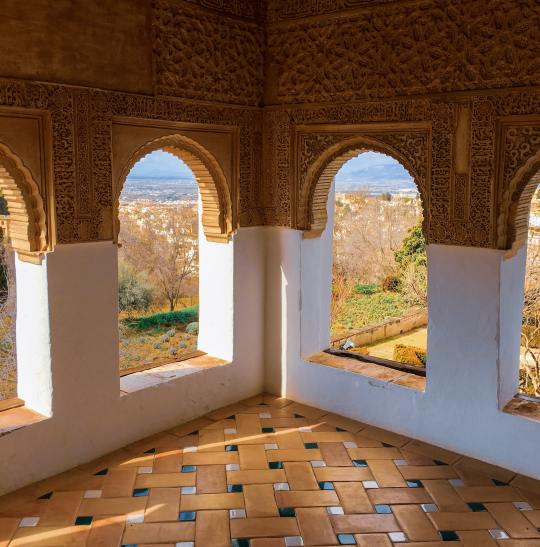
Alhambra, Spain
Times of Terror
With the christian advances the Muslims were gradually forced to the south of the country, eventually ending up in Granada. The Christians gave two choices to the Muslims and the Jews in their newly claimed territories, to be killed, or to be exiled. The Nasaries had made many agreements with the Christians, however, each time, the Christians broke their promises and agreements.
At one point, Beni Marine and Beni Ahmar merged their armies, and claimed back a few cities, such as Seville. Unfortunately, these advancements quickly came to an abrupt halt. It was not all futile however, as Yousef Beni Marine took back, and in turn, preserved many of the books in Córdoba, which can be found in a library in Morocco till this day.
The 2nd of February 1492, however, Granada capitulated. Shortly after, the Jews and the Muslims that originated from other countries were exiled; after 800 years they were now considered strangers in their own countries. Many Berber families that returned to Morocco, still have the keys to their forefathers' houses in al Andalus till this day. Their properties and wealth were taken from them.
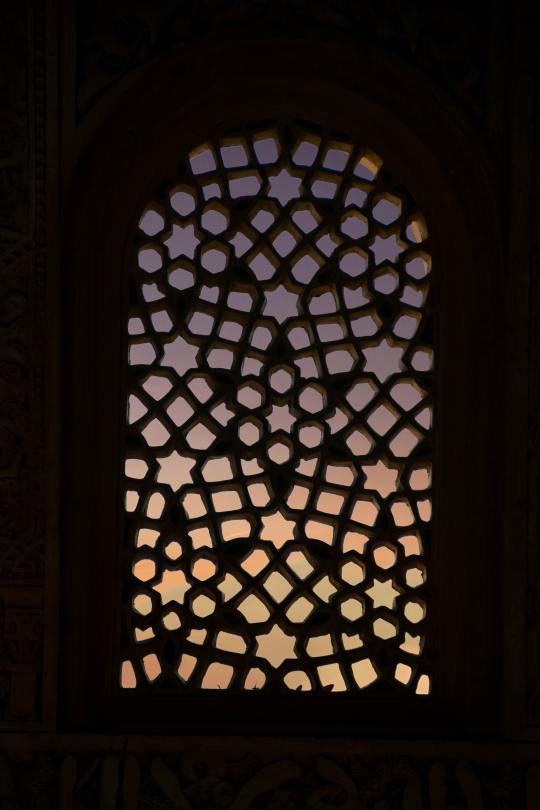
Alhambra, Granada
The fate of the Moriscos
During the 801 years of Muslim rule, an enormous amount of native Christians had converted to Islam. Their fate was even darker, they were now called “moriscos”; a kind of second degree citizens. As they had nowhere else to go, exile was not an option, leaving them with only death.
A secret police force was set up, similar to Hitlers Gestapo. Their function was to secretly search for any Spanish people that were morisco. The people that were discovered were tortured to death.
They were burned, thrown in boiling water/oil alive, hammered with rusted nails, buried alive, or kept in a black cellar until they got blind, or got their tongues cut out.
Years later, when Napoleon’s army occupied Spain, they said that they were appalled to see how the Spaniards had tortured and killed their own people in such a horrifying way.
As the native Spanish Muslims had nowhere to go, they tried to hide from the secret police.
The terror they must have felt, trying to hide from the secret police in an attempt to avoid being discovered, tortured and killed must have been indescribable.
Many of these moriscos changed their names to “blend in” while trying to escape the horror.
Ex. someone called haddad (arabic for blacksmith), would have called himself Herrero (Castillian spanish for blacksmith). If he were in danger again, he would once more change his name to Ferrer (Catalan for blacksmith). Some of the moriscos that succeeded in escaping retribution, would hide their properties, such as books and identifiable items.
Some of these items have been discovered, while reconstructing old buildings in modern times. As was the case of a lady in Toledo a few years back.
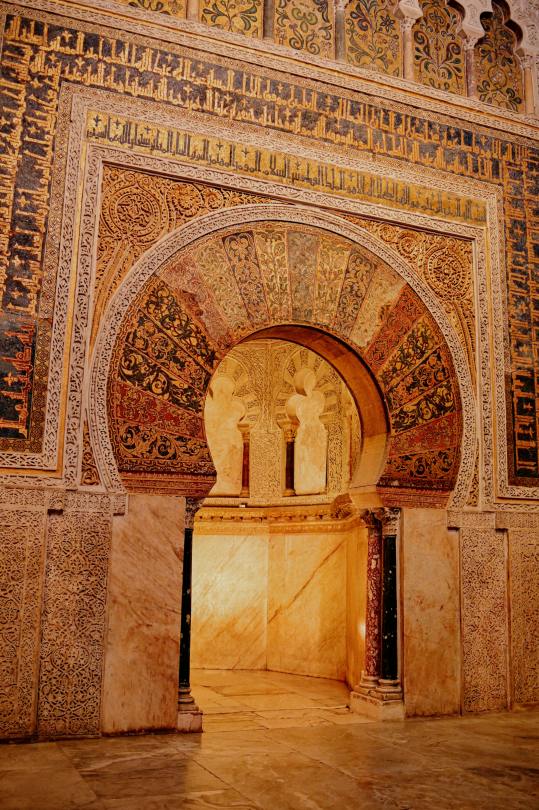
Mosque-Cathedral of Córdoba, Spain
Reflection:
The doors of collectivism and mutual respect had now closed. These doors opened with the arrival of the Moorish 801 years ago.
The doors of a multicultural society with tolerance and acceptance of others. 801 years later, these doors were closed perpetually. Left was mono-cultural, mono-ethnic country. With acceptance of only one religion, a country full of fears with all the limitations brought with it.
The new Spain was looking to finance itself by taxes from the inside, and colonization from the outside. Al Andalus was now dead and Spain crippled.
Nasarís of Granada:
Muhammad I: Muhhamad Yusuf al Ahmar I, Died at 80 years old
(1231-1272)
Muhammed II
(1272-1303)
Isma’il I
(1313-1324)
Yusuf I: died at 33 years old
(1333-1354)
Muhammed V
(1354-1390)
Muhammed VI
(???? -1492)
*Inspiration and information taken from; Egyptian historian Ragheb el sergany, from the “instituto de estudios campogibraltareños”, and from professor Juan Vernet.
#Al andalus#the end#nasarids#nasari#cordoba#alhmambra#moriscos#morisc#court of lions#water clock#mosque#cathedral#religion#writers on tumblr#writers#writblr#original content
32 notes
·
View notes
Text
Al Andalus III: One of the world's greatest civilizations; The downfall and end, Part 1.
Previous parts:
Al Andalus I: The dawn of one of the world’s greatest civilizations.
Al Andalus II: One of the world’s greatest civilizations; Times of Glory, Part 1.
Al Andalus II: One of the world’s greatest civilizations; Times of Glory, Part 2.
Al Andalus III: One of the world’s greatest civilizations; The Downfall and end, Part 1.
Al Andalus III: One of the world’s greatest civilizations; The Downfall and end, Part 2.

Córdoba, Spain
I. Abd al Rahman “the victorious “ aftermath.
The mistake of his life:
Hakam II was a great ruler, as we said before, even though he lived in the shadows of his father. Busy with reading, studying and discussing sciences and new inventions he married very late. He was over 40 years old when he finally became father for the first time, father to twins. His two sons were called Abd al Rahman and Hisham. The first born died prematurely, left was only Hisham the youngest one.
When Hisham was 12 years old Al Hakam II got paralized. In spite of being a good ruler until now Al Hakam II made the mistake of his life, a mistake that came to change the country forever. Ill and weak he had to plan for the future, better said the time after his death. He decided to put up a three people strong interim government.
These people were; 1 The prime minister: Jafar ibn Othman al Mushafi. 2 The minister of interior : Muhammad ibn abi Amer. 3 Subh. (The mother of Hisham). Muhammad ibn abi Amer was desperate for power and with Al Hakam II taking his last breath, the minister of interior started making plans. For to gain power he had to get rid of the other two interims. He started with jailing the Prime minister and when the time was right , he killed him. Subh, the mother of Hisham was easier to handle, some threats and persuasions and she was no longer a threat.
Al Mansour
Muhammad ibn abi Amer, later known as al Mansour was, to explain his personality in a simple way, contradictory! He became the most feared person in the history of al Andalus. By now he had got rid of the other two joint rulers on the list, his plan continued.
He started to rule as the only supervisor to Hisham II.Muhammad ibn abi Amer married the daughter of the general of the army in al Andalus, after using him , he later killed his father in law as well. Partly because his father in law discovered his plans. Again in need of military support this time he turned to the general of the arm stationed in Morocco, Jafar ibn Ali Hamdun, he was killed as well after being used by abi Amer.In his stead he put someone loyal to him. Just as he did with his two prior victims.
With time he succeeded at convincing Hisham that there was a conspiracy going on and to protect Hisham he needed full authority, which he got.He declared himself “Interim al Mansour”(the victorious interim). As time passed Hisham grew but he still didn’t get to rule the country.

Córdoba, Spain
The real face of al Mansour:
Al Mansour fought a total of 54 battles with the Christians northern provinces and he won all of them. To better understand his contradictory personality we have chosen two real stories. The first one is that he was told there were three Muslim women kept hostages by the Christians in León. The Christians denied the accusations and said they knew nothing of the existence of such women. The Christians blocked the.way he passed and entered the city, looked for the women in a nearby monastery but never found them. Infuriated he killed anyone who crossed his path and confiscated their possessions amidst the Christians insisting on innocence. The post war declaration with Abd al Rahman the victorious ordered the Christians to pay gisia and forbid them to harm any Muslim in their country.
The second story is about when al Mansour was extending the mosque of Córdoba to double its size. To complete the construction it was essential to purchase the surrounding buildings. During the process of purchase they came across a woman who owned a house with a garden included. In the garden grew a special palm tree, she insisted not to move unless they provided her with another house with an exact same palm tree in its garden. Al Mansour searched and found such a house with an exact same palm tree; the only problem was that the house cost five times the price of the lady’s original house. Al Mansour paid from his own money without any problems. Here we have al Mansours contradictory personality in an eggshell. Cruel and ruthless yet kind and generous.
The people of al Andalus were not particularly hostile to him. As a ruler he was fair, there was no injustice in al Andalus and there were no poor people, not yet.
By constantly terrorising Hisham about conspiracies and threatening him,al Mansour finally got his way. After years of menaces Hisham gave after and al Mansours position became inhederatory in favour of his children. By now he called himself The generous King. When he died in 1002 A.C. His position was automatically handed down to his son Abd al Malik Mansour.
The Anarchy:
After the rule of al Mansour the country fell into a complete anarchy, a total lawlessness. A disorder that lasted a very long time. During this period al Andalus was divided into 7 different pieces, every piece was a country of its own, with its independent government, police system, military and so on.
The upcoming 400 years of Andalusian history was dominated by conspiracies, killing, treason and a constant change of rulers. This ongoing disarray gradually weakened the country. At the same time the Christian northern provinces, being aware of the situation, united either by marriage like Castilla and León or by mutual agreements or interests. Little by little they grew stronger. We have chosen not to tell this period of the history of al Andalus in a detailed manner, as it would first of all be too time consuming and prolong the article unnecessary. Secondly because this time period in history is extremely confusing, complicated and complex. Instead of following 7 countries parallely, we have chosen to tell the story of one of these countries, Granada and the Nasaries.

Madinat al Zahra
#al andalus#Madinat alzhara#alzahra#cordoba#spain#history#nasarids#writers on tumblr#writers#writblr
14 notes
·
View notes
Text
@arkeoveyasam ・・・ 📌Boabdil'in Kılıcı (Muhammed XII) Son Nasarid 1492. XII. Muhammed ya da Batı dillerindeki adıyla Boabdil İspanya'da hüküm süren Müslüman Nasri Hanedanı tarafından yönetilen Gırnata Emirliği'nin 22. ve son hükümdarıdır. Gırnata'nın 2… https://t.co/ukRaB6Saz7 https://t.co/UaJ962R2gM
@arkeoveyasam
・・・
📌Boabdil'in Kılıcı (Muhammed XII) Son Nasarid 1492.
XII. Muhammed ya da Batı dillerindeki adıyla Boabdil İspanya'da hüküm süren Müslüman Nasri Hanedanı tarafından yönetilen Gırnata Emirliği'nin 22. ve son hükümdarıdır. Gırnata'nın 2… https://t.co/ukRaB6Saz7 pic.twitter.com/UaJ962R2gM
— GlobalCobra (@GlobalCobra) April 29, 2020
from Twitter https://twitter.com/GlobalCobra
0 notes